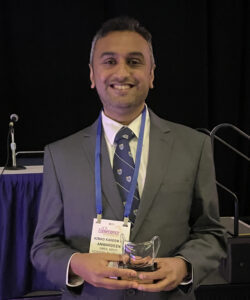Insights case studies presented in this year’s Thieves Market
CHICAGO—Each year, ACR Convergence showcases fascinating and complex clinical cases presented by rheumatology fellows in training from around the world. Two sessions are presented, one highlighting pediatric cases and one highlighting adult cases. For this year’s adult session of the Thieves Market, a committee led by Angelo Gaffo, MD, University of Birmingham, Ala., Curry Koening, MD, University of Texas (UT) Health Austin’s Rheumatology Clinic and UT Health Austin’s Musculoskeletal Institute, and Naomi Schlesinger, University of Utah, selected four case studies from over 200 entries.
In the session on Oct. 27, each presenter discussed the different diagnostic and management approaches used, provided information on how to recognize unusual presentations of common rheumatic diseases and discussed how to identify and recognize essential mimics of rheumatic diseases. Prior to revealing the final diagnosis of each case, session participants had the opportunity to compare how they would diagnose and manage the problem presented to the other session participants and the presenters. At the end of the session, participants also vote for their favorite case study. This year’s case studies were:
- Kidney You Not (case 1) presented by Michelle Benjamin, MD, from Stanford University Health Care, Stanford, Calif.;
- The Mystery of the Petite, Pigmented, Polyarthritic Lady (case 2) presented by Simren Singh, DO, from Advocate Christ Medical Center, Oak Lawn, Ill.;
- A Tale of the Silent Guard & Ceramic Core (case 3) presented by Azmad Kareem Bin Anwardeen, MBBS, MRCP, from the Rheumatology Unit, Hospital Putrajaya, Putrajaya, Malaysia; and
- When the Disease Doesn’t Fit: A Tale of Weakness, Contractures, and Clues (case 4) presented by Jennifer Abdalla, MD, MS, from LSU Health Sciences Center, New Orleans.
This year’s winner was A Tale of the Silent Guard & Ceramic Core (case 3), which won 75% of the total audience vote. The case was presented by Dr Anwardeen, and as an award, he received a complimentary registration to ACR Convergence 2026 and will be featured in a brief report publication.

Dr. Gaffo
“The session was all around an educational, fascinating and fun session,” Dr. Gaffo said. “It demonstrated the quality of our rheumatology trainees.”
A Tale of the Silent Guard & Ceramic Core
The case study featured a 25-year-old man who initially presented with seronegative inflammatory arthritis. Dr. Anwardeen said that, at first, it seemed like a straightforward rheumatic case. However, the presentation gradually revealed the need for a deeper study of a hidden immune dysfunction due to recurrent infections over time and imaging showing a porcelain aorta.
The turning point in looking beyond a diagnosis of seronegative inflammatory arthritis came when Dr. Anwardeen and his colleagues broadened their perspective beyond joints and inflammation, considering the patient’s immune function. Further testing confirmed X-linked Agammaglobulinemia, or Bruton’s disease, which showed a primary antibody deficiency that explained the patient’s infections and arthritis.
The finding changed the management approach from immune suppression to immune replacement, and the patient was started on intravenous immunoglobulin (IVIG) therapy. Cardiothoracic specialists were included to monitor his porcelain aorta.
This management approach resulted in ending the infections and needing only minimal therapy to control the patient’s arthritis.
Key Points

Dr. Anwardeen
“I chose this case because it highlights the intersection between immunology and rheumatology,” Dr. Anwardeen said. “It was not a story of immune excess, but of immune silence [in which] the absence of defense led to inflammation.”
The case reminded him that behind every atypical presentation lies a story waiting to be uncovered.
The take-home message of this case experience was that not all inflammation is caused by immune overactivity. Sometimes, it results from immune absence. Dr. Anwardeen urged clinicians to consider primary immunodeficiency as part of a diagnostic differential in patients with recurrent infections and unexplained arthritis.
He also urged clinicians to consider causes of porcelain aorta because it includes inflammation and chronic infection, as well as hereditary causes.
Explaining the title of his case, Dr. Anwardeen said the silent guard represents the patient’s absent antibody defense, and the ceramic core symbolizes the calcified aorta, calling it a silent scar of chronic inflammation.
“Ultimately, this case reminds us that medicine is not only about the immune system’s actions, but also about its silences and the lasting stories they leave behind,” he said.
Acknowledgements
Dr. Bin Anwardeen emphasized the collective team effort in making the differential diagnosis and change in subsequent treatment strategy for this patient. He specifically expressed gratitude to his consultants and mentors, Dr. Liza Mohd Isa, Dr. Nor Shuhaila Shahril and Dr. Azwarina Hanim Ramlan, for their wisdom, encouragement and constant guidance in shaping every part of the journey of the initial presentation of the patient to the ultimate diagnosis and treatment.
“Their mentorship, along with the support of my colleagues, made it possible to explore this rare case and bring Malaysia’s perspective to an international platform,” he said.
Expressing the experience as humbling, he said that it is “a reminder that even from small corners of the world, our stories in medicine can resonate globally.”
Mary Beth Nierengarten is a freelance medical journalist based in Minneapolis.


